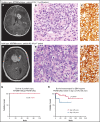A genetically distinct pediatric subtype of primary CNS large B-cell lymphoma is associated with favorable clinical outcome
- PMID: 35157770
- PMCID: PMC9131901
- DOI: 10.1182/bloodadvances.2021006018
A genetically distinct pediatric subtype of primary CNS large B-cell lymphoma is associated with favorable clinical outcome
Figures


References
-
- Dandachi D, Ostrom QT, Chong I, et al. . Primary central nervous system lymphoma in patients with and without HIV infection: a multicenter study and comparison with U.S national data. Cancer Causes Control. 2019;30(5):477-488. - PubMed
-
- Fukumura K, Kawazu M, Kojima S, et al. . Genomic characterization of primary central nervous system lymphoma. Acta Neuropathol. 2016;131(6):865-875. - PubMed

